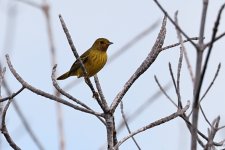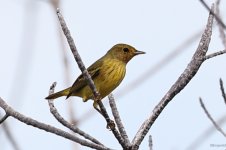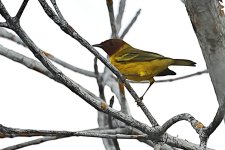-
Welcome to BirdForum, the internet's largest birding community with thousands of members from all over the world. The forums are dedicated to wild birds, birding, binoculars and equipment and all that goes with it.
Please register for an account to take part in the discussions in the forum, post your pictures in the gallery and more.
You are using an out of date browser. It may not display this or other websites correctly.
You should upgrade or use an alternative browser.
You should upgrade or use an alternative browser.
Yellow Warbler in the Yucatan. (1 Viewer)
- Thread starter Sborg
- Start date
More options
Who Replied?KenM
Well-known member
If you venture online, you should see variants of Mangrove Warbler regarding the amount of red on the head, hence my use of the word.I can't really see reddish head markings. I'd say ssp aestiva. "Classic" mangrove warbler would have an obvious reddish head
Sangahyando
Well-known member

There's also Golden Warbler (petechia subspecies group) to consider... IMO this picture on its own looks ambiguous. Are there more images of this bird?
That's Caribbean islands though, isn't it? Not one of the 3 commonly encountered forms on YucatanThere's also Golden Warbler (petechia subspecies group) to consider... IMO this picture on its own looks ambiguous. Are there more images of this bird?
only on Cozumel island which has 2 distinct and likely endemic forms (I'm unsure what the status of the most recently described one is): the "golden warbler" subspecies there is rufivertex. This group/species is otherwise only on Caribbean islands.A pic of a typical Mangrove type.
View attachment 1548681
Merlin indicates the Golden is also found in the Yucatan.
Edit: The Mexican guide indicates there are 3 common forms in Mexico. Leaving aside rufivertex you have aestiva and bryanti (=mangrove warbler). I note Clements recognises other sspp in Mexico. I still think this is aestiva, but of course they're somewhat variable.
Still not seeing pronounced reddish tones: certainly not as compared with the chest streaking. I think lighting explains what you're seeing.Here's another pic, essentially the same view. You can see red streaks on the throat and lores and behind the eye.
View attachment 1548678
Thank you. I searched and found varying amounts of red as you indicated.If you venture online, you should see variants of Mangrove Warbler regarding the amount of red on the head, hence my use of the word.
Disagree. I think the OP's description...Still not seeing pronounced reddish tones: certainly not as compared with the chest streaking. I think lighting explains what you're seeing.
...is perfectly fair - ditto for the first photo - allowing of course for (sadly common) misuse of the word 'red' when the colour is actually rufous.You can see red streaks on the throat and lores and behind the eye.
Larry Sweetland
Formerly 'Larry Wheatland'
Presumably rufous on the head in Mangrove Yellow Warbler is age and gender related, making it a trickier ID between the (sub)species.
My experience was that it was usually clear in the field. Most were mangrove; the other forms were clearly different---brighter, more yellow without any hint of reddish. Mangrove +/- always had some (obvious)rufous on the head iirc. I think it's much more difficult from these photos
Sangahyando
Well-known member

IMO the second picture shows that it's pigment and not lighting related. I'd expect individuals from the aestiva complex to have a more yellow head with less dark "staining", but I'm not an expert on the taxon.Still not seeing pronounced reddish tones: certainly not as compared with the chest streaking. I think lighting explains what you're seeing.
AveryBartels
Well-known member
I also see this as having some reddish feathering coming in on the face. I would hazard a guess that it is a young male "Mangrove" that is in the process of moulting into adult plumage. With NA wood warblers (and at least some other passerines) the head feathers can be among the last ones moulted, hence the pretty distinctive reddish streaks on the breast (likely finished/almost finished moulting) but limited reddish in the face.
Users who are viewing this thread
Total: 2 (members: 0, guests: 2)








